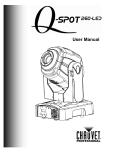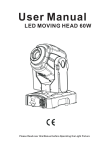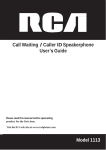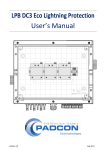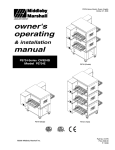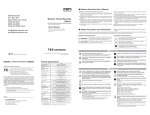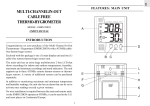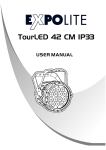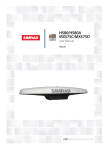Download 复件 Q-Spot_260-LED_UM3 - Hosen lighting technology limited
Transcript
User Manual LED MOVING HEAD MH LED 60D Please Read over this Manual before Operating the Light Fixture Tableof Contents 1.BeforeyouBegin .......................................................................................1 What is Included ...................................................................................................................1 Unpacking Instructions ..........................................................................................................1 Text Conventions ...................................................................................................................1 Icons ...................................................................................................................................1 Safety Notes .........................................................................................................................2 Expected LED Lifespan .......................................................................................................... 2 2. Introduction ..............................................................................................3 Feature Description .....................................................................................................................3 Features.......................................................................................................................................3 Additional Features....................................................................................................................3 DMX Channel Summary ................................................................................................................3 Product Overview .........................................................................................................................4 3.Setup .........................................................................................................5 AC Power................................................................................................................................5 AC Plug ...............................................................................................................................5 Fuse Replacement................................................................................................................5 Gobo Replacement ................................................................................................................6 LED Replacement...................................................................................................................6 DMX Linking .........................................................................................................................6 DMX Modes ........................................................................................................................6 Master/Slave Linking .............................................................................................................6 Mounting .............................................................................................................................. 7 Orientation .........................................................................................................................7 Rigging ...............................................................................................................................7 4. Operation .................................................................................................8 Control Panel Description ......................................................................................................8 Control Options .................................................................................................................... 8 Programming ........................................................................................................................8 DMX Operation ..................................................................................................................8 Stand-alone Operation........................................................................................................8 Master/Slave Operation ......................................................................................................8 Display Mode .....................................................................................................................8 Software Version ................................................................................................................8 Keylock .............................................................................................................................9 Movement Inversion ...........................................................................................................9 Color Wheel Movement .......................................................................................................9 Edit Custom .......................................................................................................................9 Range Limitation.................................................................................................................10 Move-in Black .....................................................................................................................10 Reset Control.....................................................................................................................10 System Default ...................................................................................................................10 Menu Map ......................... ....... ...... ....................................................................................11 DMX Values ..........................................................................................................................12 ADVANCED........................................................................................................................12 ADVANCED (Cont.) ............................................................................................................13 BASIC ...............................................................................................................................13 BASIC (Cont.) ....................................................................................................................14 5. Technical Information...............................................................................15 General Maintenance ..................................................................................................................15 Troubleshooting Guide........... ...... ...... ...... .................................................................................16 Exploded View .............................................................................................................................17 Parts List .............................................................................................................................18 Photometrics ........................................................................................................................18 Returns Procedure ...............................................................................................................19 Claims .................................................................................................................................19 Technical Specifications........................................................................................................ 20 6. Appendix................................................................................................... 21 DMX Primer ......................................................................................................................... 21 The Physical Medium............................................................................................................ 21 The Signals ......................................................................................................................... 21 The Functions ......................................................................................................................21 DMX Configuration ................................................................................................................21 Personalities ....................................................................................................................... 21 Starting Address .................................................................................................................. 21 Assigning Addresses ............................................................................................................22 DMX Universes ....................................................................................................................22 DMX Connectivity .................................................................................................................22 Fixture Location ...................................................................................................................22 Number of Fixtures ............................................................................................................... 22 DMX Data Cabling ................................................................................................................ 22 Making your Own DMX Cable................................................................................................. 22 DMX Cable Characteristics ....................................................................................................22 DMX Cable Connectors ........................................................................................................ 23 3-Pin to 5-Pin Conversion Chart ............................................................................................ 23 DMX Connection.................................................................................................................. 23 Master/Slave Linking ............................................................................................................. 24 Master/Slave Connection .....................................................................................................24 ID Addressing .......................................................................................................................25 Single Row Connection......................................................................................................... 25 Standard Block Connection .................................................................................................. 25 Repeated Row Block Connection .......................................................................................... 25 Other Effects .......................................................................................................................25 Sizing the Circuit Breakers .....................................................................................................26 Using the Spec Sticker..........................................................................................................26 Using the Watts/Volts Method................................................................................................ 26 Considering the Power Factor ............................................................................................... 26 Using the Volt Amps Method ..................................................................................................26 Selecting the Circuit Breaker ................................................................................................ 26 1. Before you Begin What is Included • One LED Moving head Light • One power cord with plug • Two mounting brackets • Quick Reference Guide Unpacking Instructions Text Conventions Icons Immediately upon receiving a fixture, carefully unpack the box. Check the box contents to ensure that all parts are present and that they are in good condition. If any part appears damaged from shipping, or if the box shows signs of mishandling, notify the shipper immediately. In addition, retain the box and all the packing material for inspection. In any event, save the carton and all packing material because, in case that you have to return the fixture to the factory, you will have to do so in its original box, with its original packing. See the Claims section in the Technical Information chapter. Convention Meaning 1~512 50/60 [10] A range of values A set of mutually exclusive values in the text A DIP switch to be configured Claims A fixture function, a new term, a section or a chapter “COLORado™ UM ™” The name of another publication or manual <SET> A button to be pressed on the fixture's control pan Settings A menu option that can be selected but not modified MENU > Settings A sequence of menu options to be followed A range of menu values of which one can be selected [1~10] A set of mutually exclusive menu options to choose Yes/No A value to be entered ON Icons Meaning This icon indicates critical installation, configuration or operation information. Failure to comply with this information may render the fixture partially or completely inoperative, damage thirdparty equipment, or cause harm to the user. This icon indicates important installation or configuration in formation. Failure to comply with this information may prevent the fixture from functioning correctly. This icon indicates useful, although non-critical information. The te rm “ DMX” used throughout t his document refers t o the USITTD MX512-A transmission protocol --1-- Safety Notes Please read the following notes carefully because they include important safety information about the installation, usage and maintenance of this product. It is important to read all these notes before starting to work with this product. There are no user serviceable parts inside the light. Any reference to servicing this unit you may find from now on in this User Manual will only apply to properly C we certified technicians. Do not o pen the housing or attempt any repairs unless you are one of them. Please refer to all applicable local codes and regulations for proper installation of the light. Keep this manual for future consultation. If you sell the light to another user, make sure that they also receive this manual. Personal Safety Mounting and Rigging Power and Wiring Operation Avoid direct eye exposure to the light source while the fixture is on. Always disconnect the light from its power source before servicing. Always connect the light to a grounded circuit to avoid the risk of electrocution. This product is for indoor use only! To prevent risk of fire or shock, do not expose this product to rain or moisture. Make sure there are no flammable materials close to the fixture(s) while operating. When hanging this fixture, always secure it to a fastening device using a safety cable (not provided). Always make sure that you are connecting the light to the proper voltage, as per the specifications in this manual or on the product's sticker. Never connect the light to a dimmer pack. Make sure that the power cable is not cracked, crimped or damaged. Never disconnect the fixture by pulling or tugging on the power cable. The maximum ambient temperature (Ta) is 104 F (40 C). Do not operate the fixture at a higher temperature. In case of a serious operating problem, stop using this product immediately! In t he unlikely e vent t hat your light may require ser vice, please contact our Technical Support. Expected LED Lifespan LEDs gradually decline in brightness over time, mostly because of heat. Packaged in clusters, LEDs exhibit higher operating temperatures than in ideal or singular optimum conditions. For this reason, using all color .LEDs at their fullest intensity significantly reduces the LEDs' lifespan. Under normal conditions, this lifespan can be of 40,000 to 50,000 hours. If extending this lifespan expectancy is vital, lower the operational temperature by improving ventilation and reducing the external temperature , as well as limiting the overall projection intensity --2-- DMX Channel Summary Pan Pan Fine Tilt Tilt Fine Pan / Tilt Speed 1 2 3 4 5 Function Pan Tilt Color Wheel Fixed Gobo Wheel (#1) Rotating Gobo Wheel (#2) Color Wheel 6 Gobo Rotation Fixed Gobo Wheel (#1) 7 Rotating Prism Rotating Gobo Wheel (#2) Gobo Rotation Rotating Prism Focus Dimmer Strobe 8 9 10 11 Focus Dimmer Strobe Control Control --3-- Product Dimensions Drawing Here Control Panel Base Fan Power Input On/Off Switch DMX Out Base Fan DMX In Fuse Holder --4-- 3. Setup AC Power The light has an auto-ranging power supply that can work with an input voltage range of 100~240 VAC, 50/60 Hz. Make sure that you are connecting this product to the proper voltage, as per the specifications in this guide, the product's user manual or on the product's sticker. Always connect the light to a protected circuit with an appropriate electrical ground to avoid the risk of electrocution or fire. To determine the power requirements for the light see the label affixed to the side of the fixture. Alternatively, you may refer to the technical specifications chart in the Technical Information chapter of this manual. The listed current rating indicates the maximum current draw during normal operation. Please refer to the Sizing the Circuit B reakers section in the Appendix chapter of this manual. Never c onnect the light to a r heostat ( variable r esistor) or dimmer circuit, even if the rheostat or dimmer channel serves only as a 0 to 100% switch. AC Plug The light comes with a power input cord terminated with an IEC connector on one end an Edison plug on the other end (US market). If the power cord that came with your fixture has no plug or you need to change the Edison plug, use the tablebelow to wire the new plug AC Live AC Neutral AC Ground Fuse Replacement Black White Green/Yellow Brown 1 Blue 2 Green/Yellow 3 1) With a flat head screwdriver, wedge the fuse holder out of its housing and remove the blown fuse from the holder. 2) Replace the blown fuse with a fuse of the exact same type and rating. 3) Insert the fuse holder back in its place, and reconnect power. Make sure to disconnect the fixture's power cord before replacing a blown fuse, and always replace it with a fuse of the same type and rating. --5-- Gobo Replacement 1) 2) 3) 4) Unlock the gobo cover and slide it away. Take the target gobo out of the gobo wheel. Install the new rotating gobo. Slide and lock the gobo cover. Make sure to disconnect the fixture's power cord before replacing the gobo. LED Replacement 1) Remove the head cover by loosening its screws. 2) Remove the fan cover, the head fan, the fan support and the heat sink in this order. 3) Disconnect and remove the LED. Mount and connect the new LED. 5) Reverse steps "2" and "1". Make sure to disconnect the fixture's power cord before replacing the LED. DMX Linking DMX Modes Master/Slave Linking You may link the light to a DMX controller using a standard DMX serial connection. If using other DMX compatible fixtures with the light, it is possible to control them individually with a single DMX controller. It is also possible to run several DMX compatible fixtures synchronized without a DMX controller in a master/slave operating mode. If you are not familiar with the DMX standard, please refer to the DMX Primer and DMX Connectivity sections in the Appendix chapter of this manual. The light uses the standard DMX data connection for its DMX modes, Advanced and Basic. Refer to the Operation Instructions chapter to learn how to configure the light to work in these modes. The DMX Values section will give you detailed information regarding the above-mentioned DMX modes. The Master/Slave mode allows a fixture (the master) running a preconfigured program to control several other fixtures (the slaves) without requiring a DMX controller. In this mode, all the slave fixtures will operate in unison with the master fixture. When in Master/Slave mode, the units link to each other using the standard DMX connection. If you are not familiar with the Master/Slave connectivity, please refer to the DMX Primer and DMX Connectivity sections in the Appendix chapter of this manual. The Operation chapter of this manual provides detailed instructions on how to configure the Master and Slave units. --6-- Mounting Orientation Rigging Read the safety notes at the beginning of this guide and follow their recommendations before mounting this product. Always mount this fixture in any safe position while making sure that there is adequate room around it for ventilation. Make sure to mount this fixture away from any flammable material as indicated in the Safety Notes. We recommends following the general guidelines below when mounting the light. When selecting an installation location, consider ease of access to the fixture for operation, programming adjustments and routine maintenance. Never mount the fixture in places where rain, high humidity, extreme temperature changes or restricted ventilationmay affect it. Make sure that the location where you are mounting the fixture can support its weight. Please see the Technical Specifications section of this manual for the weight requirement of this fixture. Procedure The light comes with two mounting brackets to which you can attach "C" or "O" clamps. You must supply your own "C" or "O" clamps and make sure that they are capable of supporting the weight of this fixture. You will have to use two mounting points per fixture. In addition, you may mount this product on the floor or a platform, provided it is stable and it can support the weight of the fixtures on it. Product Mounting Diagram --7-- Exits from the current menu or function Enables the currently displayed menu or sets the currently selected value in to the current function Navigates upwards through the menu list and increases the numeric value when in a function Navigates downwards through the menu list and decreases the numeric value when in a function Control Options Programming DMX Operation Stand-alone Operation Master/Slave Operation You can set the light start address in the 001~512 DMX range. This allows for the control of up to 36 fixtures in the 14-channel ADVANCED DMX mode and up to 46 fixtures in the 11-channel BASIC DMX mode. The Q-Spot 260 LED does not support ID Addressing. Carry out all the programming procedures indicated below from the control panel. Refer to the Menu Map page to learn how the menu options relate to each other. Use <ENTER> and <MENU> to change levels in the Menu M ap. This is equivalent to move right and left respectively. Use <UP> and <DOWN> to move vertically within theMenu Map options. 1) Select DMX operation a) Go to MENU > INTRO > RUN b) Select DMX512 2) Select a DMX mode a) Go to MENU > INTRO > CHANNELS b) Select BASIC or ADVANCED 3) Select the starting address a) Go to MENU > INTRO > ADDRESS b) Select a starting address, 001 ~ 498 (Advanced) or 001~501 (Basic) 1) Go to MENU > INTRO > RUN 2) Select a stand-alone operation mode (AUTO 1, AUTO 2, SOUND 1, SOUND 2, CUSTOM or TEST) 1)Configure the Master fixture a) Select a stand-alone mode, as indicated above 2)Configure the Slave fixtures a) Go to MENU > INTRO > RUN b) Select SLAVE Of all the st and-alone operation modes i ndicated ab ove, o nly " CUSTOM" is editable (see Edit Custom). 1) Go to MENU > INTRO > DISPLAY 2) Select a display mode (60 CLOSE or BRIGHT) When in the "60 CLOSE" setting, the display backlight will turn off after 60 s. When in the "BRIGHT" setting, the display backlight will stay on. 1)Go to MENU > INTRO > INFO 2)The display will show the installed software version. --8-- Keylock 1) Go to MENU > INTRO > KEYLOCK 2) Select YES or NO When i n t he " YES" set ting, the u ser will h ave to en ter t he password after 30 seconds of control panel inactivity or each time he/she turns the fixture on. The default (non-modifiable) password is < UP>, <DOWN>, < UP>, < DOWN> and <ENTER>. Movement Inversion 1) 2) 3) 4) 5) 6) Go to MENU > INVERT > PAN Select a movement mode (NORMAL or REVERSE) Go to MENU > INVERT > TILT Select a movement mode (NORMAL or REVERSE) Go to MENU > INVERT > USE Select YES to activate the new settings or NO to stop using them. Color Wheel Movement 1) 2) 3) 4) Go to MENU > INVERT > COLOR Select a movement mode (STEP or LINEAR) Go to MENU > INVERT > USE Select YES to activate the new setting or NO to stop using it. Edit Custom 1)Go to MENU > EDIT > STEP 2) Select a programming step (000~255) 3) Go to MENU > EDIT > PAN 4) Select a pan value (000~255) 5) Go to MENU > EDIT > TILT 6) Select a tilt value (000~255) 7) Go to MENU > EDIT > XY SPEED 8) Select a tilt/pan movement speed (000~255) 9) Go to MENU > EDIT > COLOR 10) Select a color wheel position (000~255) as per the DMX Values table 11) Go to MENU > EDIT > GOBO 1 12) Select a fixed gobo (000~255) as per the DMX Values table 13) Go to MENU > EDIT > GOBO 2 14) Select a rotating gobo (000~255) as per the DMX Values table 15) Go to MENU > EDIT > GOBO 2 ROT 16) Select a rotating gobo mode (000~255) as per the DMX Values table 15) Go to MENU > EDIT > PRISM 16) Select a rotating prism mode (000~255) as per the DMX Values table 17) Go to MENU > EDIT > FOCUS 18) Select a focus position (000~255) 19) Go to MENU > EDIT > DIMMER 20) Select a dimmer setting (000~255) 21) Go to MENU > EDIT > STROBE 22) Select a strobe setting (000~255) as per the DMX Values table 23) Go to MENU > EDIT > TIME 24) Select the duration of this step (000~255) 25) Go to MENU > EDIT > USE 26) Select YES to save the settings for this step or NO to delete them. 27) Repeat steps "3" to "26" for the other steps To r epeat the Custom s teps in a n e ndless loop mode, c onfigure the " TIME" setting of the last step as "0". --9-- Range Limitation 1)Go to MENU > RANGE > P/START 2)Select the starting point for the limited pan (000~255) 3)Go to MENU > RANGE > P/FINISH 4)Select the finishing point for the limited pan (000~255) 5)Go to MENU > RANGE > T/START 6)Select the starting point for the limited tilt (000~255) 7)Go to MENU > RANGE > T/FINISH 8)Select the finishing point for the limited tilt (000~255) 9)Go to MENU > RANGE > USE 10)Select YES to activate the new settings or NO to stop using them. Move-in Black 1) Go to MENU > SPECIAL > BLACK 2) Select YES to enable the 3 seconds delay or NO to make the blackout immediate. Reset Control 1)Go to MENU > SPECIAL > RESET 2)Select DMX to enable the DMX controller to reset the fixture (Control function) or NO to reset the fixture only from the control panel. System Default 1)Go to MENU > DEFAULT > DEFAULT 2)Select YES to default the fixture to its original factory settings. --10-- --11-- ADVANCED Channel Function 000 .... 255 000 .... 255 000 .... 255 000 .... 255 000 .... 255 000 .... 016 017 .... 033 034 .... 050 051 .... 067 068 .... 084 085 .... 101 102 .... 118 119 .... 135 136 .... 152 153 .... 255 000 .... 009 010 .... 019 020 .... 029 030 .... 039 040 .... 049 050 .... 059 060 .... 069 070 .... 079 080 .... 089 090 .... 099 100 .... 114 115 .... 129 130 .... 144 145 .... 159 160 .... 174 175 .... 189 190 .... 204 205 .... 219 220 .... 234 235 .... 255 000 .... 009 010 .... 019 020 .... 029 030 .... 039 040 .... 049 050 .... 059 060 .... 069 070 .... 079 080 .... 099 100 .... 119 120 .... 139 140 .... 159 160 .... 179 180 .... 199 200 .... 219 220 .... 255 000 .... 060 061 .... 158 159 .... 255 000 001 .... 004 005 .... 127 128 .... 132 133 .... 255 000 .... 255 000 .... 255 0~540° Fine movement control 0~270° Fine movement control Fast~Slow White Red Yellow Magenta Green Orange Blue Light blue Light green Rainbow or linear effect No gobo Gobo 1 Gobo 2 Gobo 3 Gobo 4 Gobo 5 Gobo 6 Gobo 7 Gobo 8 Gobo 9 Shaking gobo 9 Shaking gobo 8 Shaking gobo 7 Shaking gobo 6 Shaking gobo 5 Shaking gobo 4 Shaking gobo 3 Shaking gobo 2 Shaking gobo 1 Flow effect No gobo Gobo 1 Gobo 2 Gobo 3 Gobo 4 Gobo 5 Gobo 6 Gobo 7 Shaking gobo 7 Shaking gobo 6 Shaking gobo 5 Shaking gobo 4 Shaking gobo 3 Shaking gobo 2 Shaking gobo 1 Flow effect Gobo indexing CW rotation (Slow~Fast) CCW rotation (Slow~Fast) No function Prism engaged (no rotation) CCW rotation (Slow~Fast No function CW rotation (Slow~Fast) Dark~Bright (Continues on next page) --12-- ADVANCED 000-----031 032-----063 064-----095 096-----127 128-----159 160-----191 192-----223 224-----255 000-----019 020-----039 040-----059 060-----079 080-----099 100-----119 120-----139 140-----159 160-----179 180-----199 200-----219 220-----255 Close Open Strobe (Slow~Fast) Open Pulse strobe effect (Slow~Fast) Open Random strobe effect (Slow~Fast) Open No function Pan/tilt black activation (3 s delay) Pan/tilt black deactivation (3 s delay) Auto 1 (3 s delay) Auto 2 (3 s delay) Sound 1(3 s delay) Sound 2(3 s delay) Custom Test (3 s delay) No function Reset (3 s delay) No function 000-----255 000-----255 000-----016 017-----033 034-----050 051-----067 068-----084 085-----101 102-----118 119-----135 136-----152 153-----255 000-----009 010-----019 020-----029 030-----039 040-----049 050-----059 060-----069 070-----079 080-----089 090-----099 100-----114 115-----129 130-----144 145-----159 160-----174 175-----189 190-----204 205-----219 220-----234 235-----255 0~540° 0~270° White Red Yellow Magenta Green Orange Blue Light blue Light green Rainbow or linear effect No gobo Gobo 1 Gobo 2 Gobo 3 Gobo 4 Gobo 5 Gobo 6 Gobo 7 Gobo 8 Gobo 9 Shaking gobo 9 Shaking gobo 8 Shaking gobo 7 Shaking gobo 6 Shaking gobo 5 Shaking gobo 4 Shaking gobo 3 Shaking gobo 2 Shaking gobo 1 Flow effect --13-- 000-----009 010-----019 020-----029 030-----039 040-----049 050-----059 060-----069 070-----079 080-----099 100-----119 120-----139 140-----159 160-----179 180-----199 200-----219 220-----255 000-----060 061-----158 159---- 255 000 001-----004 005-----127 128-----132 133-----255 000-----255 000-----255 000-----031 032-----063 064-----095 096-----127 128-----159 160-----191 192-----223 224-----255 000-----019 020-----039 040-----059 060-----079 080-----099 100-----119 120-----139 140-----159 160-----179 180-----199 200-----219 220-----255 --14-- No gobo Gobo 1 Gobo 2 Gobo 3 Gobo 4 Gobo 5 Gobo 6 Gobo 7 Shaking gobo 7 Shaking gobo 6 Shaking gobo 5 Shaking gobo 4 Shaking gobo 3 Shaking gobo 2 Shaking gobo 1 Flow effect Gobo indexing Clockwise rotating from slow to fast Anti-clockwise rotating from slow to fast No function Prism engaged (no rotation) CCW rotation (Slow~Fast) No function CW rotation (Slow~Fast) Dark~Bright Close Open Strobe: Slow~Fast Open Pulse strobe effect: Slow~Fast Open Random strobe effect: Slow~Fast Open No function Pan/tilt black activated (activated after 3 s) Pan/tilt black deactivated (activated after 3 s) Auto 1 (activated after 3 s) Auto 2 (activated after 3 s) Sound 1(activated after 3 s) Sound 2(activated after 3 s) Custom Test (activated after 3 s) No function Reset (activated after 3 s) No function General Maintenance To maintain optimum performance and minimize wear, the user should clean the light fixtures frequently. Usage and environment are contributing factors in determining the cleaning frequency. As a rule, the user should clean the fixtures at least twice a month. Dust build up reduces light output performance and can cause overheating. This can lead to reduced light source life and increased mechanical wear. We recommends cleaning the fixture's external optics with a soft cloth using normal glass cleaning fluid. To clean a fixture, follow the below recommendations: Unplug the fixture from power. Wait until the fixture is cold. Use a vacuum (or dry compressed air) and a soft brush to remove dust collected on the external vents and reachable internal components. Clean all external optics and glass surfaces with a mild solution of glass cleaner or isopropyl alcohol, and a soft, lint free cotton cloth or a lens cleaning tissue. Apply the solution directly to the cloth or tissue and drag any dirt and grime to the outside of the lens. Gently polish the external glass surfaces until they are free of haze and lint. When cleaning units with a movable mirror, you should keep the contact with the mirror surface to a minimum to avoid scratching or damaging it. Always dry the external optics and glass surfaces carefully after cleaning them. If the fix ture has on e or compressed air. refrain from spinning them using compressed air. --15-- Troubleshooting Guide LED connection problems Faulty LED Faulty LED driver Faulty head fan Fixture is on Head fan is off Faulty LED driver Faulty base fan Fixture is on Base fan is off Faulty power supply Faulty color wheel motor Faulty sensor board Color wheel problem Faulty X/Y control board Faulty prism motor Faulty prism belt Prism problem Faulty X/Y control board Faulty gobo wheel motor Blocked gobo wheel Gobo wheel problem Faulty sensor board Faulty X/Y control board Faulty pan motor Faulty pan belt Faulty magnetic sensor Pan movement problem Faulty optical sensor Faulty X/Y control board Faulty tilt motor Faulty tilt belt Faulty magnetic sensor Tilt movement problem Faulty optical sensor Faulty X/Y control board Circuit breaker/fuse keeps Excessive circuit load tripping/blowing Short circuit along the power wires No power Loose or damaged power cord Fixture does not power up Blown fuse Faulty On/Off switch Faulty internal power supply Wrong DMX addressing Damaged DMX cables Wrong polarity on the controller Fixture does not respond to DMX Loose DMX cables Faulty DMX interface Faulty Display board Non DMX cables Bouncing signals Reconnect LED Replace LED Replace LED driver Replace head fan Replace LED driver Replace base fan Replace power supply Replace color wheel motor Replace sensor board Fixture is on LED is off Replace X/Y control board Replace prism motor Replace prism belt Replace X/Y control board Replace gobo wheel motor Unblock Replace sensor board Replace X/Y control board Replace pan motor Replace pan belt Replace magnetic sensor Replace optical sensor Replace X/Y control board Replace tilt motor Replace tilt belt Replace magnetic sensor Replace optical sensor Replace X/Y control board Check total load placed on the electrical circuit Check for a short in the electrical wiring Check for power on power outlet Check power cord Replace fuse Replace On/Off switch Replace internal power supply Check control panel and unit addressing Check DMX cables Check polarity switch settings on the controller Check cable connections Replace the display board Replace the display board Use only DMX compatible cables Install terminator as suggested Install an optically coupled DMX splitter right after the fixture with the strong signal Install an optically coupled DMX splitter after unit #32 or before Keep DMX cables separated from power cables or fluorescent/black lights Long cable / low level signal DMX signal problems Too many fixtures Interference from AC wires If you still ex perience t echnical problems a fter tr ying the a bove s olutions, c ontact our Technical Support. --16-- Exploded View --17-- Front lens cover Prism Prism motor Motor driver board Rotating gobo wheel LED board Heat sink Moving head fan Arm cover Tilt motor Display/main board Base fan Mounting bracket X/Y control board Right base cover 3-pin XLR A socket 3-pin XLR B socket IEC power input and fuse socket On/Off switch Fixed gobo wheel Color wheel Wheel motor Pan motor Left base cover P114-Q260LFL P114-Q260PRSM P113-Q260LP P188-Q260LED P169-Q260LED P222-Q260LED P222-Q260LHS P131-MVNHD P300-Q260LA P113-Q260LEDT P173-Q260LED P131-24V15A P125-Q260LED P175-Q260LED P300-Q260BB P135-XLRA P135-XLRB P190-Q260LED P100-SWTCH P169-Q260LEDS P149-Q260LED P113-Q260LG P113-Q260LEDP P300-Q260BB Power supply Tilt belt Pan belt Rotating gobo wheel belt Fixed gobo wheel belt Color wheel belt Prism belt Fixed gobo wheel motor Color wheel motor P142-Q260LED P118-4863M P118-3M291 P118-Q260LRG P118-Q260LSG P118-Q260LC P118-Q260LP P113-Q260LSG P113-Q260LC --18-- Returns Procedure The user must send the merchandise prepaid, in the original box, and with its original packing and accessories. We will not issue call tags. Call us and request a Return Merchandise Authorization Number (RMA #) before shipping the fixture. Be prepared to provide the model number, serial number and a brief description of the cause for the return. The user must clearly label the package with a Return Merchandise Authorization Number (RMA #). We will refuse any product returned without an RMA #. DO NO T write t he RMA # directly on t he b ox. Instead, write it o n a properly affixed label. Once you are given an RMA #, please include the following information on a piece of paper inside the box: • Your name • Your address • Your phone number • The RMA # • A brief description of the symptoms Be sure to pack the fixture properly. Any shipping damage resulting from inadequate packaging will be the customer's responsibility. As a suggestion, proper UPS packing or double-boxing is always a safe method to use. We reserves the right t o u se it s own discretion t o repair o r replace returned product(s). Claims The carrier is responsible for any damage incurred during shipping. Therefore, if the received merchandise appears to have damages caused during shipping, the customer must submit the damage report and any related claims with the carrier, not ours. The customer must submit the report upon reception of the damaged merchandise. Failure to do so in a timely manner may invalidate the customer's claim with the carrier. For other issues such as missing components or parts, damage not related to shipping, or concealed damage, the customer must make claims to us within seven (7) days of receiving the merchandise. Technical Specifications Weight & Dimensions Length................................................................................................................................. 11.4 in (290 mm) Width .................................................................................................................................. 11.6 in (295 mm) Height ................................................................................................................................. 19.1 in (485 mm) Weight ................................................................................................................................... 30 l bs (13.6 kg) Power Auto-ranging ................................................................................................................. 100~ 240 V, 50/60 Hz Power Consumption @ 120 V, 60 Hz .............................................. 150 W , 1.2 A (operation), 0.1 A (inrush) Power Consumption @ 240 V, 50 Hz.............................................. 145 W , 0.6 A (operation), 0.1 A (inrush) Light Source LED................................................................................................ ................................. 60 W, 50,000 hours Quantity ........................................................................................................................................................ 1 Photo Optic Luminance at 2 m ............................................................................................................................ 5,400 l ux Beam angle .............................................................................................................................................. 15° Control & Programming Data input ...................................................................................................... locking 3-pin XLR male socket Data output ................................................................................................. l ocking 3-pin XLR female socket Data pin configuration .................................................................................... pi n 1 shield, pin 2 (-), pin 3 (+) Protocols............................................................................................................................ USITT DMX512-A DMX Channels ............................................................................................................................... 11 and 14 --19-- 6. Appendix DMX Primer The DMX protocol (USITT DMX512-A) is a networking protocol that enables a universal DMX controller device to control the features of multiple DMX compatible fixtures, whether par cans, wash lights, moving heads, follow spots, foggers , proprietary fixture controllers, etc. As any other networking protocol, the USITT DMX512-A describes the physical medium, the signals and the functions they control. The Physical Medium The DMX controller connects to it associated DMX compatible fixtures using a DMX connection. This connection consists of a series of jumps between the DMX controller and the various DMX compatible fixtures, also known as a daisy chain connection. In this type of connection, the DATA OUT of one fixture or the DMX controller connects to the DATA IN of the next fixture, and so on. Each DMX fixture links to the previous and next DMX fixture or controller using a DMX cable. This type of cable consists of a section of shielded, two-conductor twisted pair cable with one 3-pin XLR male connector on one end and a 3-pin XLR female connector on the other end. The XLR connectors pin-out is as follows: pin 1 is the Common (shield), pin 2 is Signal Negative (S-) and pin 3 is Signal Positive (S+). The Signals The DMX signal stream is unidirectional, from the DMX controller to the DMX compatible fixtures. These signals conform to the EIA-485 standard. The stream of DMX signals consists of 512 individual, sequential channels that form a frame. The DMX controller constantly sends frames of DMX signals to the DMX connection, even if not all of the 512 channels are in use. Because of this constant transmission method, there can be only one DMX controller in a DMX connection. Otherwise, the DMX signals sent by one controller would interfere with the signals sent by the other controller(s). The Functions Each DMX channel can have any unitary value in the 000~255 range. Each DMX compatible fixture uses as many consecutive DMX channels as features the user can control. The sequential numbers assigned to each DMX channel (1~512) are also known as DMX addresses. The function each DMX channel has and the results of assigning a value to each depend on each controlled fixture. Some fixtures only use a single DMX channel, while others may require 15 or more DMX channels to control all their functions. The DMX fixture configuration consists in determining how many channels each fixture will need as well as assigning the corresponding DMX channels to each fixture in order to size correctly the DMX controller. Personalities Most DMX fixtures use multiple personalities, each of them requiring a different number of channels, depending on the number of features it enables. The number of DMX channels used by a fixture may vary from only one (usually the general dimmer control) to 15 or more, as mentioned above. When the job does not require using all the fixture's capabilities, the user can select a more basic personality (less channels), thus allowing the DMX controller to accommodate more DMX fixtures. Starting Address For the DMX controller to control each DMX fixture, the user must first configure each fixture's personality. This will determine the number of required channels to control the fixture. Each channel will have a DMX address assigned to it. However, since assigning a particular DMX address to each channel is impractical, the user will only need to configure on each fixture the DMX address that corresponds to the fixture's Channel 1. This is the fixture's starting address. The fixture will automatically assign the other channels to the subsequent DMX addresses. Once this assignment is complete, and based on the number of channels it uses, the fixture will respond to the DMX signals sent to the range of DMX channels that begins with the starting address. For example, a fixture that uses six DMX channels and whose starting address is 100, will accept DMX data sent by the DMX controller to channels 100, 101, 102, 103, 104, and 105. --21-- DMX Configuration (Cont.) Assigning Addresses The user must carefully assign the starting addresses for each individual fixture to avoid DMX channel overlapping. If the DMX channels do overlap, the affected fixtures could operate erratically. However, the user may decide to configure two or more similar fixtures with the same personality and starting address. In this case, all the fixtures with the same starting address will operate at unison. DMX Universes A DMX universe is the set of DMX compatible fixtures connected to the same DMX daisy chain, which are receiving DMX data from the same DMX controller using the same set of 512 DMX channels. Although in most cases an installation will consist of only one DMX universe, it could be necessary to define two or more universes because of constrains imposed by the distance or the number of features. Most DMX controllers support only one universe, although some DMX controllers may support two or more universes. Each universe will have its own separated DMX daisy chain. A DMX compatible fixture can only be part of a single DMX universe. DMX Connectivity Connecting the DMX fixtures to a DMX controller in small to medium installations is usually a rather simple operation that requires a minimum of tools and some planning (not including the actual fixture rigging and configuration). However, in large installations it may be necessary to plan carefully the position and cabling of each fixture to avoid unexpected problems. Fixture Location Number of Fixtures The order in which the fixtures connect to the DMX controller is not important and it has no effect on how a controller communicates to each fixture. However, the user should always define a physical location for the fixtures that provides for the easiest and most direct cabling to the controller and other fixtures. When using a DMX controller, the combined number of channels required by all the fixtures on the serial data link determines the number of fixtures the DMX controller has to support. Conversely, the number of onboard sliders, page buttons and fixture buttons limits the number of discrete DMX channels a DMX controller can support. To comply with the E IA-485 standard, which is t he b ase f or t he US ITT DMX512-A protocol, do not connect more than 32 fixtures without using a DMX optically-isolated splitter. Doing otherwise ma y result i n deterioration of the digital DMX signal. DMX Data Cabling You must use DMX compliant data cables to link two or more DMX compatible fixtures. You may purchase our certified DMX cables directly from a dealer/distributor or construct your own cable. USITT recommends limiting the total length of t he DMX c able (from the first fixture/controller to the last fixture) to 300~455 m (985~1,500 ft). Making your Own DMX Cable If you choose to create your own DMX cable, make sure to use data-grade cables that can carry a high frequency signal and are less prone to electromagnetic interference Use a Belden@9841 or equivalent cable, which meets the specifications for EIA RS- 485 applications. Do not us e standard microphone cables for D MX applications because they cannot transmit DMX data reliably over long distances. DMX Cable Characteristics The DMX data cable must have the following characteristics: Type: shielded, 2-conductor twisted pair Maximum capacitance between conductors: 30 pF/ft Maximum capacitance between conductor and shield: 55 pF/ft Maximum resistance: 20 ohms/1000 ft Nominal impedance: 100~140 ohms --22-- DMX Connectivity (Cont.) DMX Cable Connectors Each DMX cable must have a male, 3-pin XLR connector on one end and a female, 3pin XLR connector on the other end. DMX Connector Configuration To DMX Input (Female) To DMX Output (Male) To avoid signal transmission problems and interference, it is always advisable to connect a DMX signal terminator, as seen below. 120 ohm, ¼W resistor between pin 2 (DMX -) and pin 3 (DMX +) on the output of the last fixture. Test all DMX cables with an ohmmeter to verify their correct polarity and to make sure that there are no short-circuits between any of the pins, or between any pin and ground. If th e Common wire (shield) touched the chassis ground, a ground l oop could form, which may cause the fixture to perform erratically. 3-Pin to 5-Pin Conversion Chart If you use a DMX controller or fixture with a 5-pin DMX connector, you will need to use a 5-pin to 3-pin adapter. The chart below details a proper cable conversion. Ground/Shield Negative (-) signal Positive (+) signal Not Used Not Used DMX Connection Pin1 Pin 2 Pin 3 Pin 1 Pin 2 Pin 3 Pin 4 Pin 5 Make sure that the fixtures with which you are working can operate in DMX mode, not in a proprietary connection mode. Refer to the fixtures' manual to learn how to enable their respective DMX modes. The procedure below illustrates a possible DMX connection method. 1) Connect the 3-pin, male connector of the first DMX cable to the DMX Output connector (3-pin, female) of the DMX controller. 2) Connect the 3-pin, female connector of the first DMX cable coming from the controller to the DMX Input connector (3-pin, male) of the first DMX fixture. 3) Connect the 3-pin, male connector of the second DMX cable to the DMX Output connector (3-pin, female) of the first DMX fixture. 4) Connect the 3-pin, female connector of the second DMX cable coming from the first DMX fixture to the DMX Input connector of the second DMX compatible fixture. 5) Continue linking the other DMX fixtures in the same way. --23-- DMX Connectivity (Cont.) DMX Controlle Other DMX Compatible Fixtures Generic DMX Data Connection Diagram Master/Slave Linking Third DMX Cable Second DMX Cable First DMX Cable The Master/Slave mode allows one fixture (the master) to run a preconfigured program to control several other fixtures of the same model (the slaves) without requiring a DMX controller. In this mode, all the slave fixtures will operate in unison with the master fixture. If a fixture supports the Master/Slave mode, it will have some sort of programming function to configure it as master or slave. Those fixtures that only support DMX mode cannot operate in Master/Slave mode. Master/Slave Connection Make sure the fixtures with which you are working are capable of operating in Master/Slave mode. When working in Master/Slave mode, most fixtures use the DMX data connection as well. The difference in this case is that there is no DMX controller involved. Refer to the fixtures' manual to learn how to configure them to work in Master/Slave mode. The procedure below illustrates a possible connection method. 1) Connect the 3-pin, male connector of the first DMX cable to the DMX Output connector (3-pin, female) of the master fixture. 2) Connect the 3-pin, female connector of the first DMX cable coming from the master fixture to the DMX Input connector (3-pin, male) of the first slave fixture. 3) Connect the 3-pin, male connector of the second DMX cable to the DMX Output connector (3-pin, female) of the first slave fixture. 4) Connect the 3-pin, female connector of the second DMX cable coming from the first slave fixture to the DMX Input connector (3-pin, male) of the second slave fixture. 5) Continue linking the other slave fixtures in the same way. 6) Follow the steps in fixtures' manual to configure the fixtures as master and slaves. Other Slave Fixtures Second DMX Cable Generic Master/Slave Connection Diagram --24-- First DMX Cable ID Addressing Single Row Connection ID Addressing is a sub-addressing method by which each fixture, apart from its starting address, can also have an "ID" address in the 1~66 range. This allows users to multiply the number of fixtures they can control with a single DMX controller. Many fixtures have at least one DMX personality or mode that enables ID addressing. In this case, one of the channels of such DMX mode is in charge of selecting an ID address. When using ID addressing, setting the value of the ID addressing channel to "0" allows for the simultaneous control of all the fixtures with the same starting address, regardless of their particular ID address. ID addressing is also a tool for creating special lighting effects by having several fixtures sharing the same starting DMX address and ID address, as indicated below. The figure below shows a simple DMX layout that uses four fixtures, all with the same DMX address and a unique ID address for each fixture. This allows the user to control simultaneously the whole group of units at that DMX address by setting the ID Addressing channel to 0. Similarly, the user can control each fixture at that DMX address independently by first selecting the DMX address and then using the ID Addressing channel to locate the target ID address. Single Row ID Addressing Diagram Standard Block Connection Repeated Row Block Connection In the Standard Block connection, the fixtures appear in repeated rows of the same length to form a block. For instance, three rows of fixtures with three fixtures per row to form a 3 x 3 block. Each of the fixtures has unique, sequential ascending ID addresses for the controller to control each fixture individually. In this type of connection, the fixtures appear in repeated rows or columns of the same length to form a block. For instance, there may be three columns of fixtures with three fixtures per column to form a 3 x 3 block. In this case, the fixtures form groups, each with its own sequential ascending ID addresses. This way, the controller will control each group of fixtures individually. Repeated Block Connection For other types of effects, you may group the fixtures in diagonal lines or place them in random positions within a single block. --25-- Sizing the Circuit Breakers Using the Spec Sticker Calculating the total current drawn by the fixtures connected to a particular circuit is not complicated if the installer has the right information at hand and knows how to interpret it. With the fixture's current draw information, the installer can calculate and select the right circuit breaker size (rating) to which they can connect a group of fixtures. Our fixtures come with a sticker that indicates the current they consume in a circuit at the specified voltage. This greatly simplifies calculating the total current drawn. For instance, if the sticker on the fixture indicates, "0.1 A @ 115 VAC, 60 Hz" and the installer is connecting 12 of them on the same 115 VAC circuit, to determine the total current required by the fixtures it would be enough to do this simple calculation: 0.1 A x 12 = 1.2 A Using the Watts/Volts Method Considering the Power Factor Some installers may prefer to determine the current drawn by the fixture by dividing its power consumption, indicated in watts (W), by the voltage (V) on the circuit. As an example, assuming that a certain fixture consumes 240 W and it is connected to a 120 VAC circuit, the current it draws would be: 240W / 120 V 2A The above method is accurate only with fixtures whose power factor (PF) is equal, or very close, to "1." Otherwise, the calculated current may be too low with respect to the actual current drawn by the fixture. In fact, as the PF decreases, the difference between the current calculated using the watts/volts method and the actual current increases. Therefore, for fixtures with a PF below "0.9," the installer must always consider the fixture's PF when using the watts figure to calculate the current it draws. For the above example, if the published fixture's PF were "0.7," the resulting drawn current would be as follows: 2 A / 0.7 = 2.8571 A This is approximately equal )( to 2.86 A, 2.9 A, or even 3 A, depending on the installer's desire for accuracy. In other words, the actual current ended up being close to 50% higher than originally calculated. Using the Volt Amps Method If the fixture's sticker indicates the power consumption in "volt amps" (VA), the calculation of the drawn current is simply the result of dividing the amount in VA by the voltage on the circuit (V). For a fixture with a consumption of 360 VA, the calculation would be as follows: 360 VA / 120 V = 3 A Note that when the power consumption is in VA, the fixture's PF is never part of the current draw calculation. Selecting the Circuit Breaker The National Electric Code (NEC) determines that circuit breakers should handle 80% of their rated capacity for continuous loads (those being on for three or more hours) and 100% for intermittent loads. For safety reasons, We recommends assuming that all loads are continuous. After calculating the total current the fixtures connected to a particular circuit will draw, the installer must consider the 80% rule indicated above. For a total current of 22 A, the calculation is as follows: 22 A * 1.25 = 27.5 A The installer should use a 30 A CB because the immediately lower CB rating, 25 A, would not be enough for this load. --26--




























